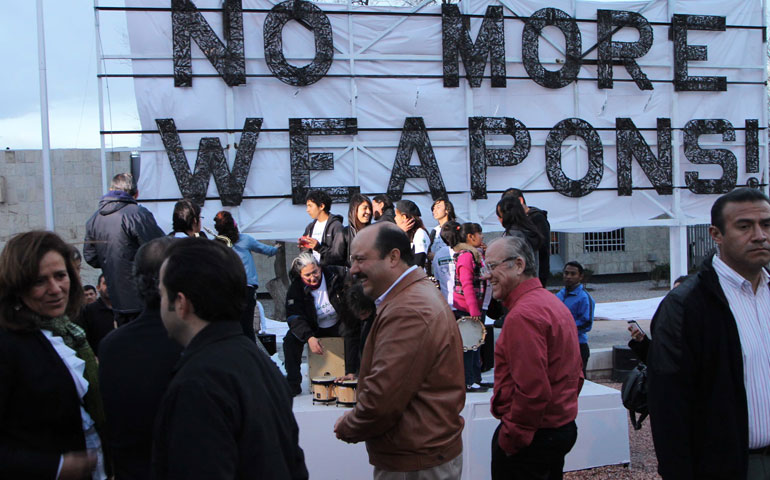
Mexican President Felipe Calderón inaugurates a billboard near the border of the United States with the message "No more weapons" on Feb. 16, 2012. (Newscom/Getty Images/AFP/Jesus Alcazar)
Editor's note: This article is Part 1 of 3 in a series focusing on gun violence in Mexico. Part 2 of 3 Blame crosses US-Mexico border
Mexico, a state with highly restrictive gun laws, minimal arms manufacturing, and only one gun shop in the entire country, is awash in firearms, many of them from the United States. A study published last year by the Trans-Border Institute at the University of San Diego estimates that upward to a quarter-million weapons are purchased in the U.S. and smuggled into Mexico annually.
Amid the hyperviolence of Mexico's war on drugs, this southward flow of illicit arms has evoked consternation and pleas for reform of U.S. gun policy from officials and activists on both sides of the Rio Grande. But others say curbing the illicit trafficking of American arms will have little effect on the complex network of violence that has claimed the lives of tens of thousands of Mexicans in the past few years.
The flow of weapons
"No More Weapons!" reads a giant billboard that stands just south of the U.S.-Mexico border beside a bridge leading into the Mexican city of Juárez. The sign's enormous letters, crafted from crushed firearms seized by Mexican authorities, add heft to a demand specifically directed at Mexico's northern neighbor.
At the billboard's inauguration in February 2012, then President Felipe Calderón begged the "dear people of the United States" to help end the "terrible violence" in Mexico. "The best way to do this," he said, "is to stop the flow of automatic weapons."
Ironically, Calderon's 3-ton sign on the Juárez bridge overlooks a gun buyer's paradise. For scattered along the U.S. side of the 2,000-mile border are 6,700 licensed gun shops, convenient, if unwitting, supply points for illicit firearms that are loaded into trucks that daily trundle over the bridge past the no-weapons billboard and into Mexico.
The country is experiencing an epidemic of gun violence. After years in decline, Mexico's homicide rate tripled during the Calderón presidency (2007-12). Up to 121,000 persons were murdered. Of those, 47,000-70,000 were victims of what some researchers have categorized as "organized crime-style homicides," a term that recognizes perpetrators include soldiers and police as well as hit men related to narco-cartels.
While Mexico's current homicide rate (23.7 per 100,000) is slightly lower than the regional average (25.9 per 100,000), "no other country in the Western Hemisphere has seen such a large increase in the number of homicides over the last five years," write the authors of a 2012 Trans-Border Institute report on drug violence in Mexico. The country's current average of 1,500 murders per month under President Enrique Peña Nieto is only slightly lower than what it was under Calderón.
And guns are increasingly the weapon of choice. Used in 20 percent of all homicides in the 1990s, they are the killing tool in half of today's murders. Mexicans are shooting each other with pistols, handguns, revolvers and even military-style assault weapons.
How many of those firearms originate in the U.S. is a question that interests Topher McDougal, an associate professor of economic development at the University of San Diego's Kroc School of Peace Studies. The MIT-trained economist is the co-author of "The Way of the Gun: Estimating Firearms Traffic Across the U.S.-Mexico Border," a report published in March 2013 by the Trans-Border Institute and the Brazil-based Igarapé Institute. Previous studies of U.S. gun flow into Mexico made estimates based on weapons seized at the border, but McDougal said there was no way of knowing what percentage of the total flow those catchments represented. So he and fellow researchers David A. Shirk, Robert Muggah and James H. Patterson looked at the U.S. gun shops -- their projected sales and proximity to the border -- and developed an econometric model to estimate the volume, dollar value and demand for guns trafficked south.
The institutes' study found that as many as 253,000 guns are annually trafficked into Mexico, representing about 2.2 percent of the total demand for U.S.-sold firearms. The weapons, typically bought in the U.S. through "straw men" purchases and then carted south, provided $127 million annually in revenue between 2010-2012 to U.S. gun dealers and arms manufacturers, who are "literally making a killing," said McDougal. Sever the Mexico supply route and 47 percent of all U.S. licensed firearms dealers would go out of business, according to the report.
McDougal's estimate is much higher than previous totals based on guns retrieved. The U.S. Justice Department's Bureau of Alcohol, Tobacco, Firearms and Explosives reported in 2012 that of the more than 99,000 guns that Mexican authorities seized and submitted to the ATF for tracing between 2007 and 2011, 68,000 were "U.S.-sourced."
But guns seized represent only a small portion of the weapons trafficked south, according to McDougal and his colleagues, who discovered that Mexican and U.S. authorities are seizing only about 15 percent of the illicit firearms entering Mexico.
That low figure does not surprise Adam Isacson, senior associate for regional security policy at the Washington Office on Latin America. Isacson, who frequently travels to Mexico, said U.S. border officials rarely scrutinize southbound vehicles and Mexican authorities check less than 20 percent of the time. The U.S. authorities simply don't have the capacity, he said, adding, "Can you imagine the backup of traffic into El Paso [Texas] if they checked every car crossing the bridge into Juárez each morning?"
The ability to prevent arms trafficking is complicated by various U.S. gun laws restricting the collection and publication of information on how a gun is acquired. The government is prohibited from storing records of individual gun purchases and can only trace and publicize limited aggregate data on weapons retrieved at a crime scene. Revealing the location of the original retailer, for example, is not allowed.
To get around these obstacles, Trans-Border Institute researchers advise providing information on gun sales tax revenues at the county level, which would give a fairly detailed estimate of guns sold in shops along the border. Any unusual uptick in sales would alert law enforcement officials to investigate. The researchers also recommend prohibiting cash transactions for guns, creating a Mexican firearms database, and developing a background check that would vet for straw purchasers.
"To simply require a 'clean record' is inadequate," McDougal said, "because people who are hired to purchase arms for a third party are hired for their record. Even if Congress were to adopt a universal background check, this wouldn't prevent straw purchases because you have no way of knowing if the purchaser is going to resell the gun."
'No longer domestic'
The March 2013 Trans-Border/Igarapé report came out amid a resurgence of the national debate on gun control sparked by the December 2012 grade-school shooting in Newtown, Conn. McDougal hopes his research will help recast the debate and raise awareness of the cross-border effects of U.S. gun policy. "Just as foreign policy is no longer foreign because of globalization, domestic policy is no longer domestic," he said.
When the U.S. federal ban on assault weapons expired in 2004, Mexican homicides escalated immediately and significantly, according to recent research. The report "Cross-Border Spillover: U.S. Gun Laws and Violence in Mexico," published in 2013, found that after the ban ended, gun-related deaths increased 35 percent in Mexican counties adjacent to Arizona, New Mexico and Texas, states with permissive gun laws, but stayed constant in counties south of California, where a state ban on assault weapons remains in place.
"It is interesting that for so long, the U.S. has complained about the supply of drugs coming up from Mexico," McDougal said. "Now this is a mirror issue. The U.S. says of the drugs that it is a supply-side problem. The difference here is that the Mexican government has never said the drugs are a legal right of Mexican citizens."
[Claire Schaeffer-Duffy is a longtime NCR contributor.]


